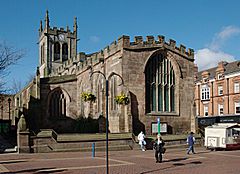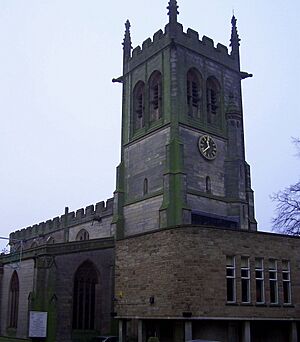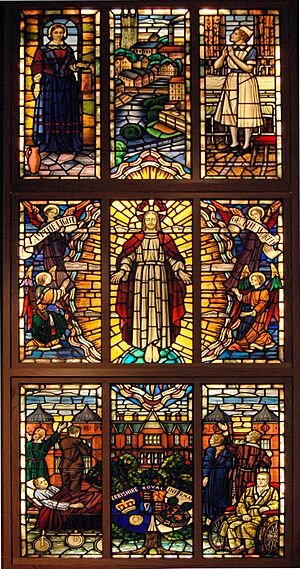St Peter's Church, Derby facts for kids
Quick facts for kids St Peter's in the City |
|
|---|---|
 |
|
| 52°55′12″N 1°28′33″W / 52.920°N 1.4757°W | |
| Location | Derby, Derbyshire |
| Country | England |
| Denomination | Church of England |
| Website | http://www.stpetersderby.org.uk |
| History | |
| Founded | circa 1045 |
| Architecture | |
| Style | Norman |
| Years built | circa 1050 |
| Administration | |
| Parish | Derby St Peter's |
| Diocese | Derby |
St Peter's in the City is an old and important Church of England church in Derby, England. It is still used for church services today. The church building is very old, dating back to the 11th century. Its tower has eight bells that ring before Sunday morning services.
The church and its walls were given a special "Grade II* listed" status in 1952. This means they are very important historical buildings.
Contents
A Look at the Church's History
How Old Is St Peter's Church?
St Peter's Church was first mentioned around the year 1042. It was also written about in the Domesday Book of 1086. This book was a big survey of England ordered by William the Conqueror.
In 1137, the church became part of Darley Abbey. This lasted until the monasteries were closed down much later.
Changes and Rebuilding Over Time
The church was rebuilt in 1338 by John de Crich. During this time, the south aisle and a special chapel called a Chantry were added. Even though it was rebuilt around 1350, some original Norman parts can still be seen. These are at the eastern end of the church. Windows from the 14th century are still in the south and north aisles. St Peter's is the only medieval church left in Derby city centre.
In 1509, the church's roof was made lower. New windows were put in above the main part of the church. The arch leading to the altar area was made wider. The eastern end of the church was also shortened, and a new east window was put in. The tower was rebuilt then too. The church bells, which many people in Derby know well, were made around 1636. They are still used regularly, and one bell has never needed to be remade!
Later, in the late 1700s, extra seating areas called galleries were added. But in 1852, the altar area was fixed up. Old seating and galleries were removed. Plaster was taken off the walls to show the old wooden roof. More changes happened in the 1860s. In 1898, the west end of the church and the tower were completely rebuilt. This was done carefully to match the old parts of the church. In 1970, new rooms for meetings, coffee, and offices were added at the west end.
Important Moments in History
Events That Shaped the Church
In 1349, a terrible sickness called the Black Death came to Derby. Many people died, including the vicar of St Peter's.
In 1530, a man named Robert Liversage set up a special chapel. Every Friday, thirteen poor people were paid a silver penny for attending a service. People really wanted to be among those thirteen! The Liversage Almshouses, which are homes for the poor, are still nearby. The church's vicar and wardens help manage them.
A blind rope maker named Joan Waste from St Peter's parish was put on trial in 1556. She was accused of not following the official church beliefs. She refused to change her mind and was sadly burned at the stake.
The plague returned to Derby in 1586. It started in St Peter's parish.
Around 1650, Oliver Cromwell took an old chair from the church. This chair had been given to St Peter's in 1593. Amazingly, the chair was found at an auction in 1960. A church warden was able to get it back for the church!
Robert Bakewell, a famous metalworker who passed away in 1752, is buried in the churchyard.
It is said that William Cowper wrote the hymn Hark my Soul it is the Lord in the church in 1768.
Church Organs and Music
The Church's Musical Instruments
The church had a pipe organ from 1820. This was replaced in 1852 by a new organ. Another new organ was given to the church in 1921.
The pipe organ used today was put in place in 1986. You can find details about this organ on the National Pipe Organ Register.
People Who Played the Organ
Many talented people have played the organ at St Peter's Church over the years. Some of them include Mr. Stenson around 1843, Charles Norton around 1854, and W.H.L. Dodd, who played for a very long time from 1890 to 1945.
St Peter's Church Today
A Busy Community Hub
In 2010, St Peter's Church raised money to move and display a beautiful Florence Nightingale stained glass window. This window was originally made for the chapel at the Derbyshire Royal Infirmary. On October 9, 2010, the window was officially rededicated in a special service.
Even though people thought about closing the church in the late 1960s because not many people were attending, it is now a very important part of Derby. The church is at the centre of the "St Peter's Quarter," an area that works to make the city better.
In 2012, the church was improved to keep serving the community. These changes help the church offer many services to the St Peter's Quarter and the whole city. The Derby City Chaplaincy uses St Peter's as its main base. For the past few years, a project called "Christmas Lunch on Jesus" has given Christmas food hampers to many families in Derby.
See also
- Grade II* listed buildings in Derby
- Listed buildings in Derby (Arboretum Ward)



